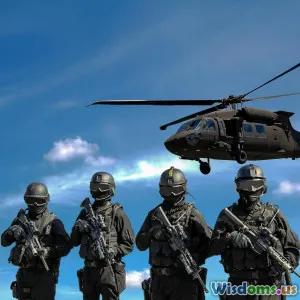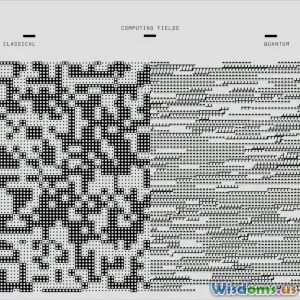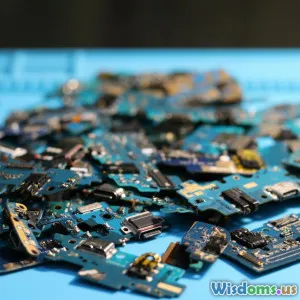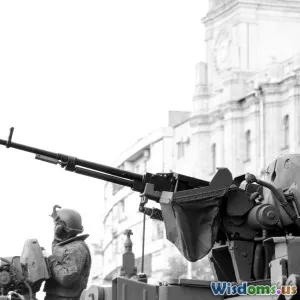
Top Ten Most Innovative NonLethal Weapons in Modern Peacekeeping
8 min read Explore the top ten groundbreaking nonlethal weapons reshaping modern peacekeeping efforts worldwide. (0 Reviews)
Top Ten Most Innovative NonLethal Weapons in Modern Peacekeeping
Introduction
In a world constantly evolving with complex conflicts and fragile peace agreements, minimizing casualties and collateral damage has become a paramount mission for peacekeepers. Traditional weapons, with their lethal impact, frequently exacerbate tensions, lead to unintended loss of life, and derail peaceful resolutions. Enter nonlethal weapons—a class of military technology designed to incapacitate or dissuade adversaries without causing permanent harm or death. These tools are transforming the landscape of modern peacekeeping missions, providing effective means of crowd control, area denial, and threat neutralization while fostering safer interactions.
This article dives into the top ten most innovative nonlethal weapons that are redefining how peacekeepers operate worldwide. Combining emerging technologies and tactical innovation, these weapons represent a future where force can be assertive yet humane.
1. The Active Denial System (ADS)
Dubbed a “heat ray,” the Active Denial System uses millimeter-wave electromagnetic energy to create an intense burning sensation on the skin’s surface without causing permanent injury.
Developed by the U.S. military, ADS targets the outer layer of the skin, inducing a sensation so uncomfortable that crowds disperse almost instantaneously. Its range of about 500 meters makes it ideal for crowd and perimeter control in volatile peacekeeping zones.
Example: The system was tested for crowd control during the 2015 NATO exercises in Europe, highlighting its precision in dispersing confrontations without lethal engagement.
2. Long Range Acoustic Device (LRAD)
Sound is power. The LRAD produces focused, high-decibel sounds and voice commands that can be directed at specific individuals or groups, causing discomfort or disorientation.
Various peacekeeping units employ LRADs to communicate clearly over chaotic disturbances or to control crowds without physical confrontation. This technology ranges between warnings, communication, and high-intensity deterrents.
Real-World Insight: During the 2019 Hong Kong protests, law enforcement used LRADs to assert control without escalating to physical violence, highlighting its role in maintaining order amid tension.
3. PepperBall Systems
Evolving from classic pepper spray, PepperBall weapons fire projectiles filled with powdered capsaicin aerosol, providing rapid, wide-area incapacitation without physical injury typical of bullets.
These paintball-like pellets rupture on impact, dispersing the irritant instantly. Their efficiency and reduced risk of serious injury make them essential tools for peacekeepers managing tight urban engagements or riotous crowds.
Data: Studies show PepperBall can control crowds with a 70% faster compliance rate compared to traditional spray methods.
4. Flash Bang/ stun grenades with Smart Detonation
Modern flashbangs generate intense light and sound to incapacitate, but innovations added remote or smart detonation mechanisms enabling timed and pinpoint detonation.
Use in hostage rescues or ambush situations allows peacekeepers to neutralize threats while minimizing risks to civilians.
Technological Note: New models can reduce disorientation times to under 5 seconds, optimizing incapacitation while decreasing long-term impact.
5. Taser Shockwave Systems
Starting as handheld devices, the latest shockwave Tasers deploy multiple electrodes to incapacitate groups at once without lethal harm.
The Shockwave variant includes portable launchers capable of discharging multiple conductive probes into crowds, delivering electrical pulses that temporarily immobilize without causing lasting damage.
In the Field: Various UN peacekeeping forces have tested Taser Shockwave in sub-Saharan Africa for riot control with promising results.
6. Sticky Foam Projectors
This futuristic solution sprays a highly adhesive foam that restricts movement by instantly immobilizing an individual or group.
Aggressors find it impossible to maneuver or wield weapons effectively once coated — an ideal means for immobilizing without injury.
Development: Introduced by biotech companies, the foam degrades safely within hours, aligning with humanitarian standards of temporary restraint.
7. Laser Dazzler Devices
Dazzlers emit intense, non-damaging light beams that temporarily blind or disorient opponents.
Widely adopted in peacekeeping for crowd control and vehicle interdiction, these lasers help degrade hostile capability, enabling safer arrests or dispersals.
Example: The UK’s Ministry of Defence successfully uses dazzlers to halt aggressive vehicles without firing traditional arms.
8. Nonlethal Railguns
Though railguns are often associated with lethal applications, experimental nonlethal variants use kinetic energy projectiles designed to stun rather than pierce or injure.
These shot deliver blunt force with adjustable impact, capable of dispersing hostile formations over distance without bloodshed.
Insight: Such railguns are still under research but symbolize next-generation efforts for scalable, nonlethal force.
9. Micro-Drone Disruptors
Tiny drones equipped with microphone-jamming signals and startling lights scour hostile zones to disrupt communications and confuse adversaries.
Peacekeepers deploy these to surveil and noninvasively incapacitate organized threats before escalation becomes necessary.
Innovation: Micro-drones were field-tested in peacekeeping areas of the Middle East to reduce reliance on aggressive force measures.
10. Vehicle Stoppers (Spike Strip Alternatives)
Instead of flat spikes to puncture tires, new vehicle stoppers use deployable nets or magnetic devices that safely disable vehicles while preventing harm to occupants.
These innovations prevent high-speed chases from turning deadly while controlling movement in checkpoints or conflict zones.
Field Use: European peacekeeping missions used magnetic stoppers to safely halt unauthorized vehicles without gunfire or collision.
Conclusion
The drive for peacekeeping without bloodshed demands innovation beyond firearms and traditional weapons. Nonlethal technologies fuse humanitarian principles with tactical advantage, allowing soldiers and officers to control hostile situations without turning violent confrontations into conflicts with irreversible consequences.
From the sensational sensation of the Active Denial System’s heat rays to the silent precision of sticky foam and micro-drones, these top ten nonlethal weapons illustrate peacemaking redefined. As we advance, investment in these technologies facilitates global security by offering means to diffuse rather than ignite unstable scenarios.
By championing innovation in nonlethal deterrence, militaries worldwide can better protect civilians, reduce casualties, and ultimately bring peace where conflict once prevailed.
References:
- U.S. Department of Defense, Active Denial System Fact Sheet
- NATO Reports on Nonlethal Weapon Deployment
- Journal of Conflict Resolution, PepperBall Efficacy Studies
- UK Ministry of Defence Pub, Laser Dazzler Application
- UN Peacekeeping Operations, Nonlethal Technology Reviews
Rate the Post
User Reviews
Popular Posts





















